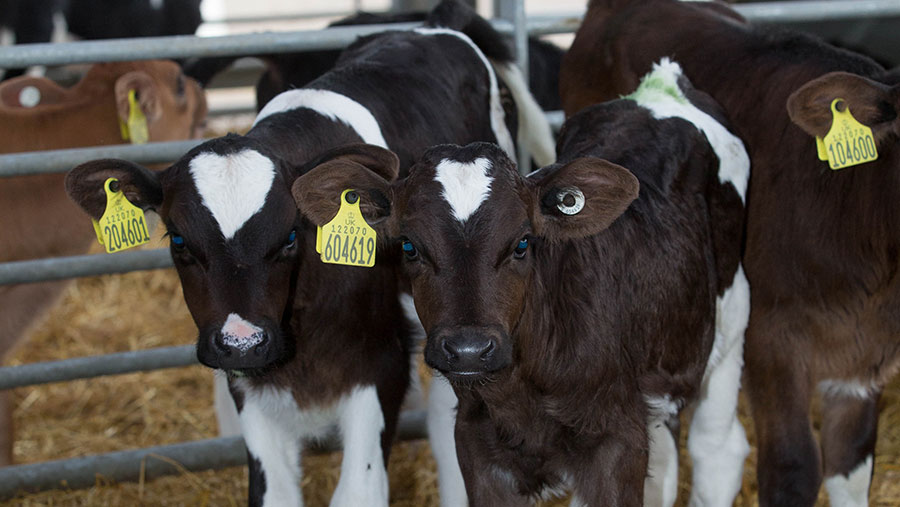Research shows benefits of pair housing calves pre-weaning
 © Tim Scrivener
© Tim Scrivener Pair housing calves before weaning can help them adapt better to different situations as they mature, leading to improved concentrate intakes and higher growth compared with those housed alone.
Professor Trevor DeVries of the University of Guelph in Ontario, Canada, explained that his research – together with that of Dr Marina von Keyserlingk of the University of British Columbia – was some of the “latest scientific evidence” cited by Tesco last year as the reason for banning its suppliers from individually housing calves pre-weaning.
See also: How to manage colostrum and minimise calf losses
Dr von Keyserlingk said farmers could make big gains by pair housing.
Her research showed:
- Pair-housed calves ate 40g/head/day more concentrate in the milk feeding stage, compared with lone housed animals, which was attributed to “social facilitation”.
- Intake differences were then carried through when individually housed and pair-housed calves were mixed into one group post-weaning. At this stage, grain was provided through a feeder that none of the calves had seen before. The individually housed calves took 50 hours to take their first grain meal, compared with the pair-housed animals which took just nine hours. The individually housed calves were then so hungry that they binged on grain, then stopped eating, then binged again – the classic signs of acidosis.
- Their growth suffered as a result, with these animals losing an average 2.5kg after mixing, with their weight fluctuating over the following 14 days.
- It took them almost a week to catch up to the intake of the pair housed calves, which “didn’t miss a beat”.
- This was explained by a social interaction test. When two calves that had never met were introduced to each other, those that had been individually housed took time to touch the other calf and were then only interested in each other. The pair-housed calves quickly touched each other and then explored the environment, which explained why they were quicker to eat.
Speaking at the Total Dairy Seminar in Stratford-upon-Avon last week (19 June), Prof DeVries referenced other studies where pair-housed calves were found to eat more during weaning and thus experienced less of a growth check at this stressful time.
Pair-housed calves achieved average weight gains of 0.7kg/day at weaning, versus 0.4kg/day in those individually housed.
Cognitive development differences
His research also looked at the cognitive learning of calves in both housing set-ups. Calves were trained to touch a screen.
If they touched the screen when it was red, they would get a milk reward. If they touched it when it was white, they would have to wait. It took both groups of calves nine or 10 sessions to learn.
However, when the colours were swapped over, significant differences emerged.
All of the social housed calves learnt to cope with the reversal. However, only 20% of the individually housed calves learnt it, with 80% never figuring it out.
“Cognitively, they couldn’t turn it around,” Prof DeVries said. “There’s something different in the development of these animals – possibly brain development differences.”
This suggested that animals that were pair-housed before weaning were better able to adapt and learn later on, which could be beneficial in the longer term.
For example, calves that were pair-housed were more open to eating novel foods that they hadn’t seen before. They also developed healthier eating patterns after weaning, eating more regularly.
This behaviour persisted to the end of the 12-week trial, suggesting this could carry on over time, which could benefit rumen health and performance.
In conclusion, Dr von Keyserlingk urged producers to pair-house calves as soon as possible after birth. “But you’ve got to work with what works best on your farm,” she said.
“Get the colostrum into them, make sure that they’re drinking well from the nipple, and then we dehorn in that first three to four days, and then we like to pair no later than day five.”
Social housing considerations
- Can you combine two individual pens together by removing the divider?
- Can you put two individual hutches together with a pen around the front of both?
- Start with pairs and get management right, then you can increase group size if desired – but ensure calves are of similar ages.
- Health problems shouldn’t increase as long as hygiene, air quality and immune status are right.
- Provide enough milk and allow calves to express sucking behaviour to prevent cross-suckling issues.
